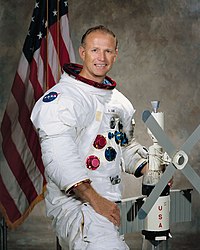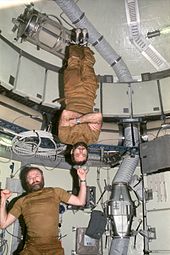Gerald P. Carr
| Gerald Carr | |
|---|---|

|
|
| Country: |
|
| Organization: |
|
| selected on | April 4, 1966 (5th NASA Group) |
| Calls: | 1 space flight |
| Begin: | November 16, 1973 |
| Landing: | February 8, 1974 |
| Time in space: | 84d 1h 15min |
| EVA inserts: | 3 |
| EVA total duration: | 15h 51min |
| retired on | June 1977 |
| Space flights | |
|
|
Gerald Paul Carr (born August 22, 1932 in Denver , Colorado , † August 26, 2020 in Albany , New York ) was an American astronaut .
Life
Carr was born in the state of Colorado but grew up in Santa Ana , Southern California . He attended Santa Ana High School , where he served as President of the Honor Society and played on the school's football team; In addition, he was a member of the Boy Scouts of America scout organization , where he achieved the highest level of Eagle Scout . After graduating from high school, he began studying at the University of Southern California in 1950 and received his engineering degree in mechanical engineering in 1954 .
At the University of Southern California, Carr was a member of the Navy Reserve Officer Training Corps and joined the United States Marine Corps upon graduation in 1954 . He first completed the officer course The Basic School at Marine Corps Base Quantico in Virginia , was subsequently trained as a military pilot in Florida and Texas and served from 1962 to 1965 in the Marine Fighter Attack Squadron 122 (VMFA-122) as a pilot of an F. -8 "Crusader" . Among other things, Carr was stationed with his unit on the aircraft carrier USS Independence , from 1965 until his move to NASA he was test director of Marine Air Control Squadron 3.
In addition to his military service, Carr studied aerospace engineering at the Naval Postgraduate School , where he obtained a Bachelor of Science degree in 1961 and subsequently a Master of Science degree from Princeton University in New Jersey in 1962 .
NASA activity
Carr joined the US space agency in 1966 with the fifth group of astronauts. Together with 18 other candidates, he was presented to the public in April. Initially, he was a member of the Apollo 8 (1968) and Apollo 12 (1969) support teams. He was also involved in the development of the moon car , which was used on the last three Apollo flights in 1971/72.
On January 19, 1972, NASA announced the crews for the three flights to the Skylab space station . Carr was nominated as the commander of the third crew ( Skylab 4 ). What was unusual about it was that Carr was given a command on his first flight. This award was last bestowed on Neil Armstrong at Gemini 8 in 1966 .
Together with pilot Bill Pogue and Edward Gibson , who officially looked after the scientific payload, Carr formed the last crew of the first American space station. The three astronauts began their mission in November 1973, which lasted three months. One of the main tasks was the observation of the newly discovered comet Kohoutek . In addition, solar research, space medicine and earth exploration were on the tightly packed work program. Of the four outboard work , Carr was involved in three: at the end of December he left the station, first with Pogue and four days later with Gibson. Just five days before landing, he got off again with Gibson for five and a half hours. When Carr and his two comrades returned to Earth in early February 1974, they had set a new long-term record of 84 days, which was not broken until 1978 by the crew of Salyut 6 .
See also
Individual evidence
- ↑ Sarah Loff: Skylab Astronaut Gerald "Jerry" Carr Dies at 88th NASA, August 26, 2020, accessed August 27, 2020 .
Web links
- Short biography of Gerald P. Carr at spacefacts.de
- NASA biography of Gerald P. Carr (English; PDF)
- Biography of Gerald P. Carr in the Encyclopedia Astronautica (English)
- Oral History Transcript , Interview from October 2000 (English)
| personal data | |
|---|---|
| SURNAME | Carr, Gerald P. |
| ALTERNATIVE NAMES | Carr, Gerald Paul (full name) |
| BRIEF DESCRIPTION | American astronaut |
| DATE OF BIRTH | August 22, 1932 |
| PLACE OF BIRTH | Denver , Colorado |
| DATE OF DEATH | August 26, 2020 |
| Place of death | Albany , New York |

